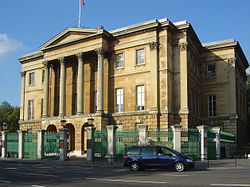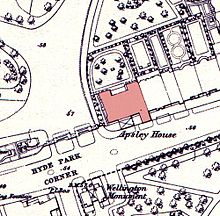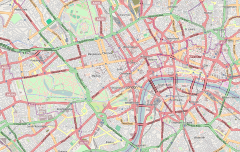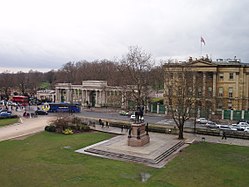Apsley House
| Apsley House | |
|---|---|
 The front of Apsley House in 2005 | |
| General information | |
| Architectural style | Neo-classical |
| Location | 149Piccadilly London,W1 |
| Country | United Kingdom |
| Coordinates | 51°30′13″N0°09′06″W/ 51.5035°N 0.1517°W |
| Client | |
| Design and construction | |
| Architect(s) |
|
| Website | |
| www | |
Listed Building– Grade I | |
| Reference no. | 1226873[1] |

Apsley Houseis the Londontownhouseof theDukes of Wellington.It stands alone atHyde Park Corner,on the south-east corner ofHyde Park,facing towards the large traffic roundabout in the centre of which stands theWellington Arch.It is aGrade I listed building.
Designed byRobert Adamin theneoclassicalstyle, the house was built forLord Apsleyin the 1770s. It was purchased byRichard Wellesley,in 1807, and passed to his younger brotherArthur,in 1817. It was sometimes referred to asNumber One, London.It is perhaps the only preserved example of an English aristocratic townhouse from this period.
The house is also called theWellington Museum,its official designation under the Wellington Museum Act 1947. Run byEnglish Heritage,much of the house is open to the public as a museum and art gallery, exhibiting theWellington Collection,a large collection of paintings, other artworks and memorabilia of the career of the 1st Duke. The9th Duke of Wellingtonretains half the house for the family's private use. The practice has been to maintain the public rooms as far as possible in the original style and decor of the 1st Duke.
History[edit]
Apsley House stands at the site of an old lodge that belonged to the crown. During theInterregnumnewer buildings were erected between what is now Old Park Lane and Hyde Park Corner. In the 1600s after theRestorationthey were leased byJames Hamilton(died 1673) and renewed by Elizabeth his widow in 1692 on a 99-year lease (Hamilton Placetakes its name from that family). Immediately before Apsley House was built the site was occupied by a tavern called the Hercules Pillars (immortalised byHenry FieldinginThe History of Tom Jones, a Foundlingas the location whereSquire Westernresides when he first journeys up to London).[2]
The house was originally built in red brick byRobert Adambetween 1771 and 1778 forLord Apsley,theLord Chancellor,who gave the house its name. Some Adam interiors survive: the Piccadilly Drawing Room with itsapsidalend and Adam fireplace, and the Portico Room, behind the giantCorinthian porticoadded by Wellington.
The house was given the popular nickname of Number One, London, since it was the first house passed by visitors who travelled from the countryside after the toll gates atKnightsbridge.[3]It was originally part of a contiguous line of great houses onPiccadilly,demolished to widenPark Lane:its official address remains 149 Piccadilly, W1J 7NT.[4]
In 1807 the house was purchased by Richard Wellesley, the elder brother of the Arthur Wellesley, but in 1817 financial difficulties forced him to sell it to his famous brother, by then the Duke of Wellington, who needed a London base from which to pursue his new career in politics.[5]
Wellington employed the architectBenjamin Dean Wyattto carry out renovations in two phases: in the first, begun in 1819, he added a three-storey extension to the north east, housing a State Dining Room, bedrooms and dressing rooms.[6]Thescagliolaornamentations, that resemblemarbleinlays, were produced inCoade stonefrom the Coade Ornamental Stone Manufactory inLambeth.[7]
The second phase, started after Wellington had become Prime Minister in 1828, included a new staircase and the "Waterloo Gallery" on the west side of the house.[6]The red-brick exterior was clad inBath stone,and a pedimented portico added.[8]Wyatt's original estimate for the work was £23,000, but the need to repair structural defects discovered during the work led to costs escalating to more than £61,000.[6]Wyatt introduced his own version of French style to the interior, notably in the Waterloo Gallery and the florid wrought iron stair-rail, described byPevsneras "just turning fromEmpireto a neo-Rococo ". Iron shutters and railings were also added to the house after the windows had been smashed during riots.[9]
The Waterloo Gallery is named after the Duke's famous victory over Napoleon at theBattle of Waterloo.The Waterloo Banquet was held annually to commemorate the famous victory of 18 June 1815. The first banquets were held in the Dining Room but in 1828 when Wyatt completed the Waterloo Gallery the banquet was moved there and became a much larger event, seating 74 as opposed to 36 in the dining room. The Duke'sequestrian statuecan be seen across the busy road, cloaked and watchful, the plinth guarded at each corner by an infantryman. This statue was cast from guns captured at the battle.
| Wellington Museum Act 1947 | |
|---|---|
| Act of Parliament | |
 | |
| Long title | An Act to transfer to the Crown Apsley House and the site, forecourt and garden thereof and certain chattels formerly belonging to the first Duke of Wellington; to provide for the use of Apsley House partly as a museum for the preservation and exhibition of the said chattels and other chattels associated with the said first Duke or his times and for other public purposes, and partly as a residence for the Dukes of Wellington; to amend the enactments relating to the Wellington estates, so as to provide for the automatic devolution of the property subject to the trusts thereof whenever there is a change in the person holding office as First Lord of the Treasury, Chancellor of the Exchequer or Speaker of the House of Commons; and for purposes connected with the matters aforesaid. |
| Citation | 10 & 11 Geo. 6.c. 46 |
| Dates | |
| Royal assent | 31 July 1947 |
Gerald Wellesley, 7th Duke of Wellington,gave the house and its most important contents to the nation in 1947, but by the Wellington Museum Act 1947 (10 & 11 Geo. 6.c. 46) the right of the family to occupy just over half the house was preserved "so long as there is a Duke of Wellington".[10]The family apartments are now on the north side of the house, concentrated on the second floor.
Gallery[edit]
-
Apsley House in 1829 byThomas H. Shepherd.The main gateway to Hyde Park can be glimpsed on the left.
-
Apsley House next to the gate
-
Thestatue of the Duke of Wellingtonfacing Apsley House.Hyde Park Cornerto the left.
-
Apsley House at night
-
Portrait ofArthur Wellesley, Duke of Wellington,byThomas Lawrence(c. 1815–16)
-
Antonio Canova's statue ofNapoleon as Mars the Peacemaker(1806)
See also[edit]
- List of monuments to Arthur Wellesley, 1st Duke of Wellington
- Stratfield Saye House– the country home of the Dukes of Wellington
- Walmer Castle– the residence of the 1st Duke asLord Warden of the Cinque Ports
- Waterloo ceremony
- Wellington Museum, Somerset
- Wellington Museum, Waterloo
Additional reading[edit]
- Jervis, Simon & Tomlin, Maurice (revised by Voak, Jonathon; 1984, revisions 1989 & 1995)Apsley House Wellington Museumpublished by the Trustees of the Victoria and Albert Museum, LondonISBN1-85177-161-1
- Nikolaus Pevsner,The Buildings of England:Londonvol. I, p. 463.ISBN0-300-09653-4
- Stourton, James (2012).Great Houses of London(Hardback). London: Frances Lincoln.ISBN978-0-7112-3366-9.
References[edit]
- ^Historic England."Apsley House (1226873)".National Heritage List for England.Retrieved1 September2013.
- ^Knight, Charles, ed. (1851),Knight's cyclopædia of London,London, p.789
{{citation}}:CS1 maint: location missing publisher (link) - ^Aspley HouseArchived19 April 2021 at theWayback Machine(English Heritage) accessed 13 March 2009
- ^149 Piccadilly, W1J 7NTArchived18 June 2022 at theWayback Machine–GoogleMaps
- ^Jervis, Simon; Tomlin, Maurice (1984).Apsley House, Wellington Museum(2004 ed.). London: Victoria & Albert Museu. p. 5.ISBN1-85177-161-1.
- ^abc"Arthur Wellesley and Benjamin Wyatt".English Heritage.Archivedfrom the original on 18 December 2011.Retrieved20 December2011.
- ^John E. Ruch, "Regency Coade: A Study of the Coade Record Books, 1813–21"Architectural History11(1968, pp. 34–56, 106–107) pp. 35, 39.
- ^Timbs, John (1858).Curiosities of London.London. p. 541.
{{cite book}}:CS1 maint: location missing publisher (link) - ^"English Heritage".english-heritage.org.uk.Retrieved19 September2023.
- ^Nicolson, Adam (April 2003)."Heritage held hostage to class war".Daily Telegraph.Archivedfrom the original on 24 September 2015.Retrieved1 November2015.
External links[edit]
- Official website
- Apsley House – English Heritage website
- Historical Images of Apsley House
- Apsley House and Park Lane,Old and New London:Volume 4 (1878), pp. 359–375
- Art museums and galleries in London
- Biographical museums in London
- Historic house museums in London
- Houses in the City of Westminster
- Museums in the City of Westminster
- English Heritage sites in London
- Grade I listed houses in London
- Grade I listed buildings in the City of Westminster
- Grade I listed museum buildings
- Arthur Wellesley, 1st Duke of Wellington
- Bathurst family
- Prime ministerial homes in the United Kingdom
- Robert Adam buildings
- Georgian architecture in the City of Westminster
- Greek Revival houses in the United Kingdom
- Neoclassical architecture in London









